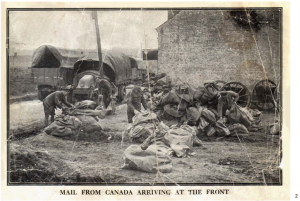Saturday, January 2, 1915
In Camp, Lark Hill, Salisbury Plains
The Battalion War Diarist wrote for this day: “Rain all day. All available men on fatigues. No parades.” [1]
 THIS DAY IN RMR HISTORY: “Ottawa, December 31. – A statement was issued by the Post Office Department today in reply to criticisms which have been made of the postal service as regards delivery of correspondence to Canadian soldiers on Salisbury Plain. On inquiry being made into a number of complaints, the Department finds no ground for them beyond the delay
THIS DAY IN RMR HISTORY: “Ottawa, December 31. – A statement was issued by the Post Office Department today in reply to criticisms which have been made of the postal service as regards delivery of correspondence to Canadian soldiers on Salisbury Plain. On inquiry being made into a number of complaints, the Department finds no ground for them beyond the delay
incidental to the disorganization of the Atlantic mail service owing to war conditions, or which is due to the incomplete addressing of correspondence by the senders.
When there are no mail boats sailing from a Canadian port, due to these having been requisitioned by the Admiralty, all mail is sent by the New York route, but owing also to the war some weeks there is only one mail boat sailing from New York to the United Kingdom. Then, when the letters do get to Salisbury Plain, a camp area of 17 miles has to be covered in their distribution. Many letters, too, contain only the name of the addressee and his regiment, whereas it is essential that the number of the battalion and the brigade be given.”
1. War Diary, 14th Canadian Battalion, The Royal Montreal Regiment, Jan 2, 1915. Library and Archives Canada, Ottawa, http://data2.collectionscanada.ca/e/e044/e001089686.jpg
2. Photo courtesy: M.I.Pirie; http://www.canadiangreatwarproject.com/general/imageGeneral.asp?ImageId=10154
3. “Post Office Explains,” The Gazette, Montreal, Quebec, Friday, January 1, 1915, pg. 6, col. 6.

